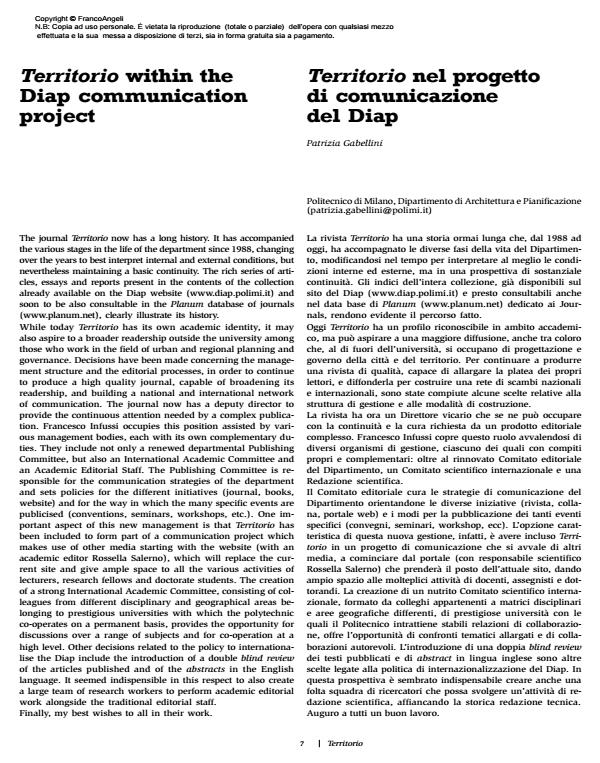Territorio within the Diap communication project
Journal title TERRITORIO
Author/s Patrizia Gabellini
Publishing Year 2010 Issue 2010/53 Language Italian/English
Pages 1 P. 7-7 File size 257 KB
DOI 10.3280/TR2010-053001
DOI is like a bar code for intellectual property: to have more infomation
click here
Below, you can see the article first page
If you want to buy this article in PDF format, you can do it, following the instructions to buy download credits

FrancoAngeli is member of Publishers International Linking Association, Inc (PILA), a not-for-profit association which run the CrossRef service enabling links to and from online scholarly content.
The journal Territorio now has a long history. It has accompanied the various stages in the life of the department since 1988, changing over the years to best interpret internal and external conditions, but nevertheless maintaining a basic continuity. The rich series of articles, essays and reports present in the contents of the collection already available on the Diap website (www.diap.polimi.it) and soon to be also consultable in the Planum database of journals (www.planum.net), clearly illustrate its history. While today Territorio has its own academic identity, it may also aspire to a broader readership outside the university among those who work in the field of urban and regional planning and governance. Decisions have been made concerning the management structure and the editorial processes, in order to continue to produce a high quality journal, capable of broadening its readership, and building a national and international network of communication. The journal now has a deputy director to provide the continuous attention needed by a complex publication. Francesco Infussi occupies this position assisted by various management bodies, each with its own complementary duties. They include not only a renewed departmental Publishing Committee, but also an International Academic Committee and an Academic Editorial Staff. The Publishing Committee is responsible for the communication strategies of the department and sets policies for the different initiatives (journal, books, website) and for the way in which the many specific events are publicised (conventions, seminars, workshops, etc). One important aspect of this new management is that Territorio has been included to form part of a communication project which makes use of other media starting with the website (with an academic editor Rossella Salerno), which will replace the current site and give ample space to all the various activities of lecturers, research fellows and doctorate students. The creation of a strong International Academic Committee, consisting of colleagues from different disciplinary and geographical areas belonging to prestigious universities with which the polytechnic co-operates on a permanent basis, provides the opportunity for discussions over a range of subjects and for co-operation at a high level. Other decisions related to the policy to internationalise the Diap include the introduction of a double blind review of the articles published and of the abstracts in the English language. It seemed indispensible in this respect to also create a large team of research workers to perform academic editorial work alongside the traditional editorial staff. Finally, my best wishes to all in their work.
Patrizia Gabellini, in "TERRITORIO" 53/2010, pp 7-7, DOI: 10.3280/TR2010-053001